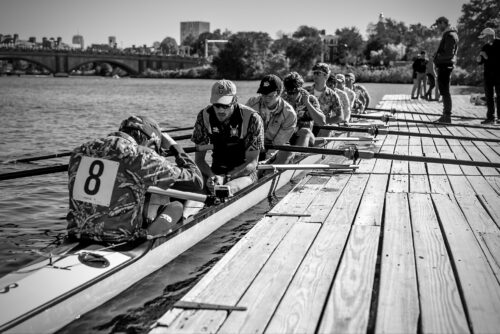Never is the prominence of crew at Harvard so clear than during the Head of the Charles Regatta, the largest rowing event in the world. 2,231 boats competed this past weekend from 619 rowing clubs, attracting . 200,000 spectators and the business of hundreds of vendors. Yet some of the race’s most important members may also be its most unrecognized. Small in size to minimize added weight and without an oar, the coxswain is often overlooked in comparison to their much larger teammates. However, their role—particularly when racing the Charles—is anything but miniscule.
“Head of the Charles is one of, if not the most, significant race for coxswains because it’s a real test of steering skill and ability to maneuver around others in an unpredictable situation,” said Hailey Kwoun ’24, a coxswain for the Harvard men’s heavyweight rowing team.
Sprint regattas are typically 2,000 meter events where competing boats race side by side in a straight line, while head regattas are time trials raced across 5,000 meters of winding river. Boats start ten seconds apart from each other, with the winner judged on their course time rather than finishing position. This makes picking the right racing line all the more crucial. “The longer the race is, the more opportunity there is to add meters on,” said Radcliffe heavyweight coxswain Holly Conlon ’23. “Especially when Head of the Charles is not a straight course.”

Justin Han ’24 had never competed in a regatta Saturday, but he cherished the opportunity to make his debut on such a hard course. “It was awesome to have one of the biggest races in the world be my first one,” he said.
Han appreciated the home court advantage Harvard students enjoy on the Charles. “The advantage we have in practicing every day on this river definitely was clear,” he said. “For example, on the Weeks [Bridge] turn, we’re told to aim for the Lowell Bell tower. That means that during the race, you don’t need to think too hard about which angle you’re gonna take because you just know to aim for the tower.”
Han’s strategy for Weeks Bridge is more than just a convenience. The turn is a sharp 90 degrees and is located in the middle of the race. It is perhaps the most notorious part of the course and is enough to stoke fear in even the most experienced navigator. “The Weeks turn is probably the bane of most coxswains’ existences,” said Kwoun. “Most coxswains will screw it up. And even if they have perfectly clear traffic, they probably still won’t get the line that they want.”
Not to be outdone, the subsequent 180 degree turn under Eliot Bridge provides a brutal one-two punch for coxswains. Their technique must be absolutely perfect to have any shot of winning their event. “If you get stuck on the outside of a turn unnecessarily, you can add tons of time onto your race,” said Conlon.
Han learned the difficulty of maneuvering these turns during a race all too well. After successfully navigating Weeks Bridge, he unfortunately crashed his boat into the side of Eliot Bridge. While incredibly disappointed to cost his team valuable time, Han could not afford to think about anything but his next move during the race.

“There’s a lot of panic when [a crash] happens; everyone’s just trying to do what they can,” he said. “As the coxswain, it’s my job to get them back in line and get them back rowing in time and with discipline to finish the race.” Han’s boat was able to recover from their crash and placed 37th, beating eight other boats in the process.
Kwoun’s experience on Saturday was not one of crisis management but that of celebration. She guided her boat to first place in the Men’s Club Four’s race, Harvard’s first victory in that event since 1973. “Head racing is really funny because you can have a general idea of how well you did compared to yourself, but you have no idea how the rest of the field did.” A few days after the event, she reflected on her performance with enthusiasm. “I’ve raced Head of the Charles three times before this and I never finished anywhere near the top, so this was extremely exciting for me,” she said.
Conlon was not happy with her boat’s 14th place in the Women’s Championship Eight’s event, but already has her eyes turned to the future. “It was disappointing, but there’s a lot to look forward to,” she said. “Our training is mostly focused on building towards the spring and our spring racing season.”
The week after Head of the Charles is eerily quiet. The fans have left and the stands have been taken down, not to return for an entire year. The river that hosted so much joy and also heartbreak is empty save for the training sessions of local schools and rowing clubs. For those who experienced this weekend firsthand, however, the magnitude of the event will resonate far longer. Harvard’s coxswains will continue to try to guide their teams to glory the same way they always have—being inconspicuous, but indispensable.
Declan Buckley ’24 (declanbuckley@college.harvard.edu) secretly wishes he rowed crew.

